From Project to Pillar: Pistons' Andre Drummond dominating in the middle
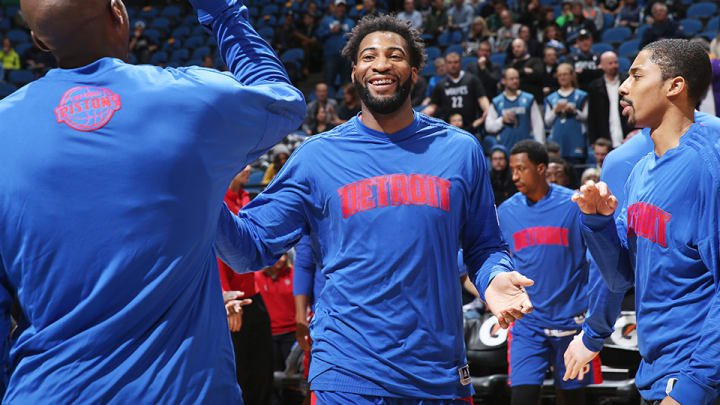
This story appears in the Nov. 30, 2015, issue of SPORTS ILLUSTRATED. To subscribe, click here.
In mid-September 2007, two weeks before training camp, members of the Magic gathered at the team’s practice facility for a pickup game that was both typical and transformative. Participants included center Dwight Howard, 22 years old and coming off his first All-Star selection, and power forward Tony Battie. A 6'11" journeyman, Battie had finally discovered a home in Orlando's low post, flanking Howard for the better part of three years. The Magic hired a new coach in the summer of ’07, Stan Van Gundy, and acquired a new wing, Rashard Lewis. But the hulking front line remained intact.
Battie and Howard formed a potent partnership, but they split up during the pickup game, since Battie was the rare player capable of outwrestling the overgrown prodigy. At one point Howard caught the ball on the block and backed Battie down. Battie raised his left forearm and planted it into Howard’s midsection. He felt a twinge in his left shoulder. Two days later he couldn’t lift the arm at all. An MRI revealed that Battie had torn his left rotator cuff and would miss 6–8 months.
Forced to reimagine the lineup, Van Gundy abandoned the idea of a traditional power forward. He deployed Lewis and Hedo Turkoglu as his starting forwards, even though both were far more comfortable on the perimeter than in the paint. The Magic, with four sharpshooters orbiting Howard, won 16 of their first 20 games. A year later they reached the Finals. Superman was all the rage, and so was the four-out, one-in system, a model of modern basketball. “It was really an accident,” Van Gundy says. Battie rehabbed his shoulder, started three games in ’08–09 and was shipped to the Nets.
LeBron's Time: Cavaliers star feeling the urgency to bring title to Cleveland
By stationing so many marksmen around the arc, Orlando drew defenders out, opening space for Howard to dive or post or kick. Mike D’Antoni had already applied some of the same principles in Phoenix, exploiting newfound crevices with Steve Nash-Amar’e Stoudemire pick-and-rolls, but the go-go Suns never had an eraser on defense like Howard. It didn’t matter if Lewis and Turkoglu were bullied inside: Howard lay in wait, denying power forwards at the rim and dominating them on the glass.
A lot of teams across today’s NBA run four-out, one-in. But how many human beings walk the Earth—let alone stalk the key—who stand nearly 7 feet tall, weigh nearly 280 pounds, run like guards, catch like shortstops, reach as high as Yao Ming and jump substantially higher? And of those, how many are willing to set cement-wall screens every 30 seconds, then barrel to the hoop and retrieve lobs at the square? Are there 10? Are there five? “Less,” says Malik Allen, a forward on the 2010–11 Magic.
A coach is lucky to happen upon one in his career. Stan Van Gundy is working on No. 2.
*****
Andre Drummond is hiding. He sits in the lobby of the JW Marriott in downtown Los Angeles, Pistons hoodie pulled over his head, wearing black sunglasses, silver headphones and a thick headband. He speaks softly, barely above a whisper, and his teeth are obscured by braces. Drummond was born 22 years ago—checking in at 12 pounds, six ounces—and he spent much of his childhood in various forms of disguise. He was 6'7" when he entered high school, but he walked with a hunch to look more like his peers, who were wary of his size. “They didn’t want to hang out with me because I was so big,” Drummond says. “They sometimes snuck into class late, and they worried I’d get them caught.”
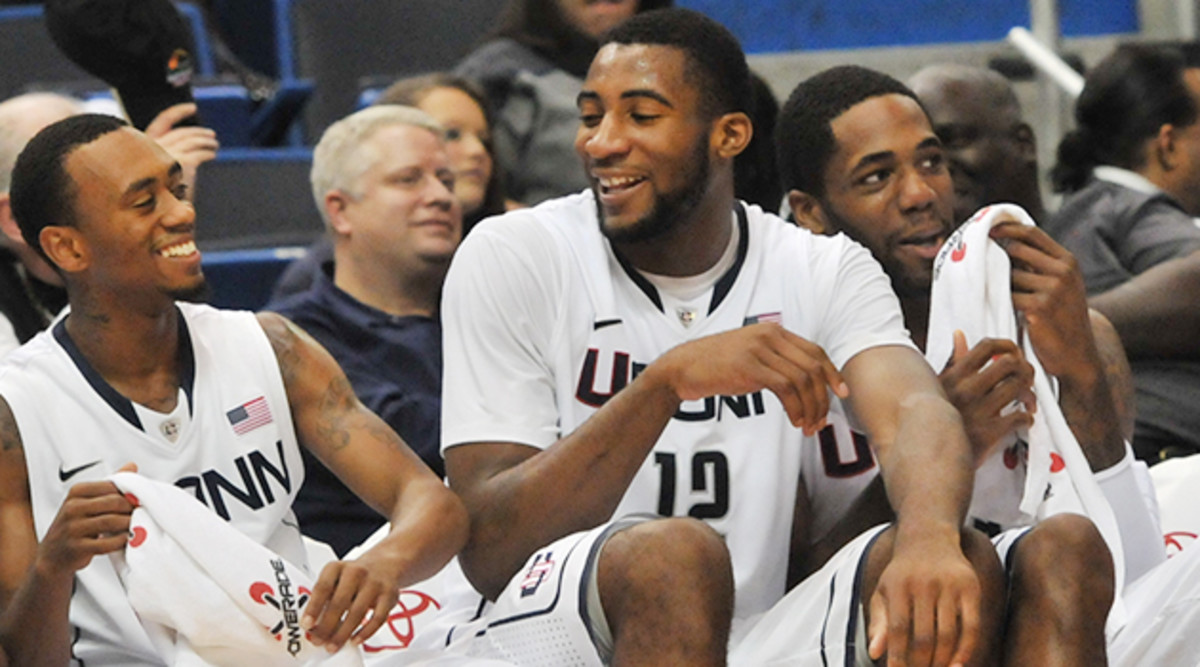
When UConn was courting Drummond, who by then had grown to 6'10", coach Jim Calhoun asked why he played basketball. He had put the same question to countless recruits, from Ray Allen to Rip Hamilton, most of whom proclaimed they were chasing greatness. Drummond replied, “It’s a great way to make friends and be part of something.” Drummond, the most decorated prospect from Connecticut since Marcus Camby emerged from Hartford 22 years ago, was a different kind of blue-chipper. He served as a resident adviser at his prep school, consoling homesick freshmen, and when the team held a basketball camp in the summer, he requested to be a camper rather than a counselor. He walked on at UConn because the team was out of scholarships when he signed, which meant he couldn’t live in the athletes’ dorm, instead spending his lone year in Storrs with regular students on the other side of campus. When he interviewed with NBA front offices before the 2012 draft, he asked Trail Blazers owner and Microsoft cofounder Paul Allen about software programs, mentioning that he enjoyed writing HTML code.
Detroit selected Drummond with the ninth pick, and he moved into a house in suburban Rochester Hills with his mother, Christine Cameron, who chauffeured him to practice because he did not have a driver’s license. Drummond’s innocence endeared him to the organization. He would stroll into the office of Joe Dumars, then the president of basketball operations, and chat for three hours. He would sign autographs in the concourse on game nights when he was injured. He would tweet when he was headed to Somerset mall until he realized why he kept getting mobbed there. The Pistons were a dysfunctional franchise, but Drummond seemed almost immune to the turmoil. “I know Detroit has been a real messed-up place,” Drummond recalls telling Dumars. “How can I help?”
His season invariably ended in April, which allowed him to take classes at UConn in May, and sneak in workouts at his hometown Middlesex YMCA. This summer, wide-eyed 17-year-old Railey Barett was working the front desk at the Y when Drummond strolled in and asked if he wanted to play 21. “Treat me like I’m somebody else,” Drummond said. He is still eager to blend, a pursuit that has become impossible now that he is at the center of the four-out, one-in.
The Craft: Rise of Andre Drummond
Since Van Gundy took over as coach and president of the team 18 months ago, reportedly spurning the Warriors, he has cleared room for Drummond the way he did for Howard. The Pistons waived power forwardJosh Smith, even though two years and $26 million remained on his contract. They let center Greg Monroebolt for Milwaukee, even though he averaged a double double. They bet everything on a 6'11", 279-pound man-child, surrounding Drummond with a promising pick-and-roll partner (point guard Reggie Jackson) and three supersized snipers (Marcus Morris, Ersan Ilyasova and Anthony Tolliver). “They might not be as talented as they were [with Monroe and Smith],” an opposing coach says, “but the pieces finally fit, and they’re featuring the right guy.”
Forget Howard. Lakers coach Byron Scott compared Drummond with “a more athletic Moses Malone” after he put up 29 points and 27 rebounds against the Blazers, 25 points and 29 rebounds against the Pacers and 20 points and 20 rebounds against the Bulls in a four-game stretch. The season is less than a month old, and Drummond has already captured Eastern Conference player of the week honors twice. He has only once left an arena without a double double. He leads the league in second-chance points, points in the paint and rebounding, with an average of 17.8 through Sunday. “He walks onto the court, and he’s got 15 and 15,” says Smith, now with the Clippers. Detroit, which hasn’t reached the playoffs since 2009, is 7–6 and beat the vaunted Cavalierson Nov. 17 behind 25 and 18 from Drummond.
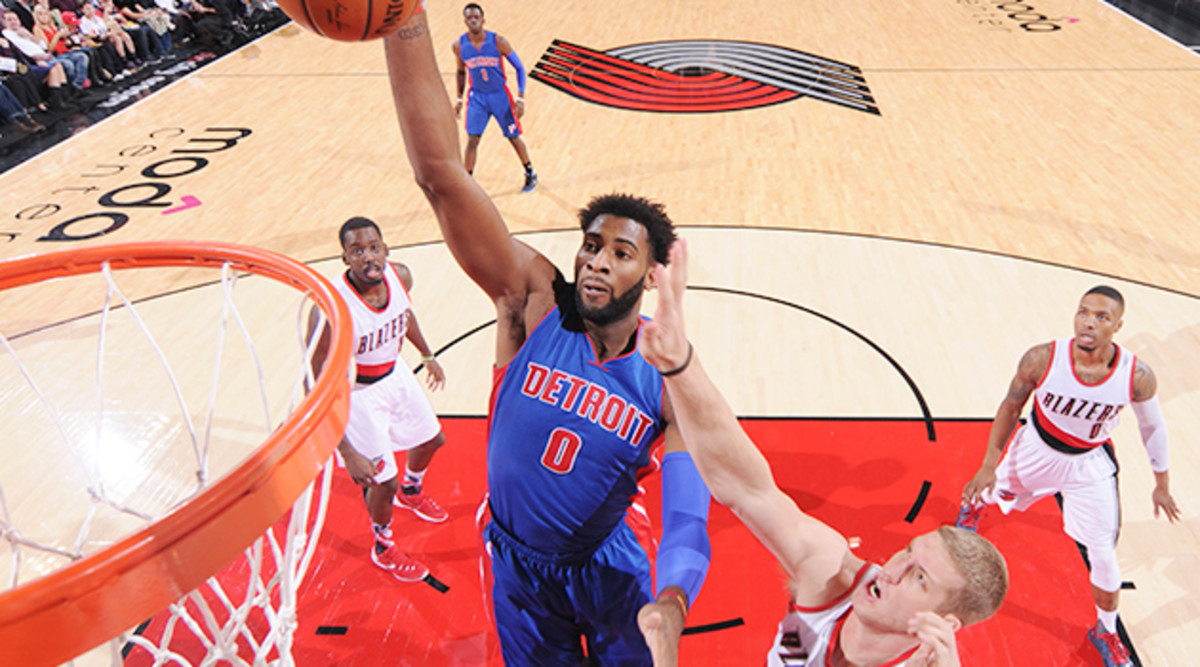
The four-out, one-in has been a boon for him. Drummond extols the benefits of the system but does not recall its origin, and for good reason. In late 2007, he was undergoing a metamorphosis of his own.
*****
Drummond grew up in Middletown, a city of 47,000 on the western bank of the Connecticut River, where everybody seemed to know his name. “He was big and tall and looked exactly like what a basketball player is supposed to look like,” says Levi Gillespie, the coach at Capital Preparatory Magnet School in nearby Hartford. “People heard about him and went to see him. But when he didn't perform the way they expected, they became disappointed. A lot of those people were mean to him—mean to his face.” Drummond and others remember the jeers at the Middlesex Y from players and parents of players who believed his prodigious gifts were being squandered. You’re tall for nothing ... You should pick another sport ... You can’t walk and chew gum.
Kobe takes final cue from Father Time
He didn’t disagree. “It was hard to watch me play,” Drummond says. “I was all over the place, tripping over myself, falling on the court, throwing up air balls.” He was cut from his middle school team in seventh grade and cried on the bus ride home. “Back then, everybody was telling me, ‘You’re terrible, you suck, you should be so much better than you are.’ It took a toll. I went through a period where it was really depressing. I felt like I couldn't do anything right.” Before his freshman year at Capital Prep, he asked his mother how he could change his fortunes. Cameron, a Jamaican immigrant who raised two children on her own as a nurse at Middlesex Hospital, did not know much about basketball. She referred to her son’s games as “comedy hour” because of his many gaffes. But she sensed he would grow into his body. She sent him back to the Y.
“I played pickup there from dawn to dusk, damn near 50 games a day, against whoever came in that gym,” Drummond says. “I closed up with the janitors.” When the competition dried up, he worked with a cousin named Victor Anderson, who taught him to dunk. “Be a beast!” Anderson implored, but Drummond struggled to see himself that way. At Capital Prep, he begged Gillespie for opportunities to play point guard, and sometimes the coach humored him, marveling at his tight handle and no-look passes. But Drummond wasn’t going to make a living running the break. “You're a big person,” Gillespie said. “You have to get comfortable in your own skin.” Drummond remained awkward but showed glimpses of otherworldly athleticism. He dunked while hitting his head on the backboard. He rebounded without bothering to box out. He blocked shots with his left hand as well as his right.
• ROSENBERG: Pistons try to gain an edge by watching every NBA game
As a junior Drummond transferred to St. Thomas More in Oakdale, Connecticut's answer to Oak Hill Academy, where at 16 he became the youngest student ever to play for legendary coach Jere Quinn—and the largest ever to top the 1-2-2 press. Physically, you’ve won the lottery,” Quinn told Drummond. “You have all the numbers. You just can’t screw them up.” So many big men toss their golden ticket in the trash, from Eddy Curry to Michael Olowokandi, and those are only the most famous examples. They often play because they can. The best play because they want to.
Open Floor: Why Kawhi Leonard could be the heir to Kobe Bryant's throne
When Drummond declared for the draft after his freshman season, Quinn regaled scouts with stories about his five-star center volunteering as an assistant coach for the freshman team so he could spend more time in the gym. But evaluators were skeptical. They saw another potentially flaky giant who attended two high schools, settled on a college three days before the beginning of the fall semester and occasionally vanished once he arrived. Drummond scored 20 points against West Virginia, one against Arkansas; 18 at Georgetown, none at Louisville. The Huskies, coming off a national championship, were one-and-done in the NCAA tournament. Several general managers picking early in the 2012 draft confused Drummond’s inconsistency for indifference. “We had concerns about work ethic,” one says, “and competitive spirit.”
Drummond held his mother’s hand under a table at Prudential Center in Newark as commissioner David Stern announced the names. “First pick, I knew it was Anthony Davis to New Orleans,” Drummond says. “Second pick, Charlotte traded Corey Maggette for Ben Gordon, so they needed a small forward. Michael Kidd-Gilchrist. Third pick, Washington, Bradley Beal. Fourth pick, Cleveland. I had a great workout there. I thought they liked me. They took Dion Waiters. Fifth pick, Sacramento, I had a weird workout there. I got poked in my eye and lost my contact. They took Thomas Robinson. No. 6 comes up. I thought Portland liked me as well. They went with Damian Lillard. No. 7 rolls around. Golden State said, ‘If you’re on the board, we might take you.’ Harrison Barnes. Then it’s No. 8, and the guy with the Raptors hat walks over. I’m thinking, I’m going to Toronto. Terrence Ross."
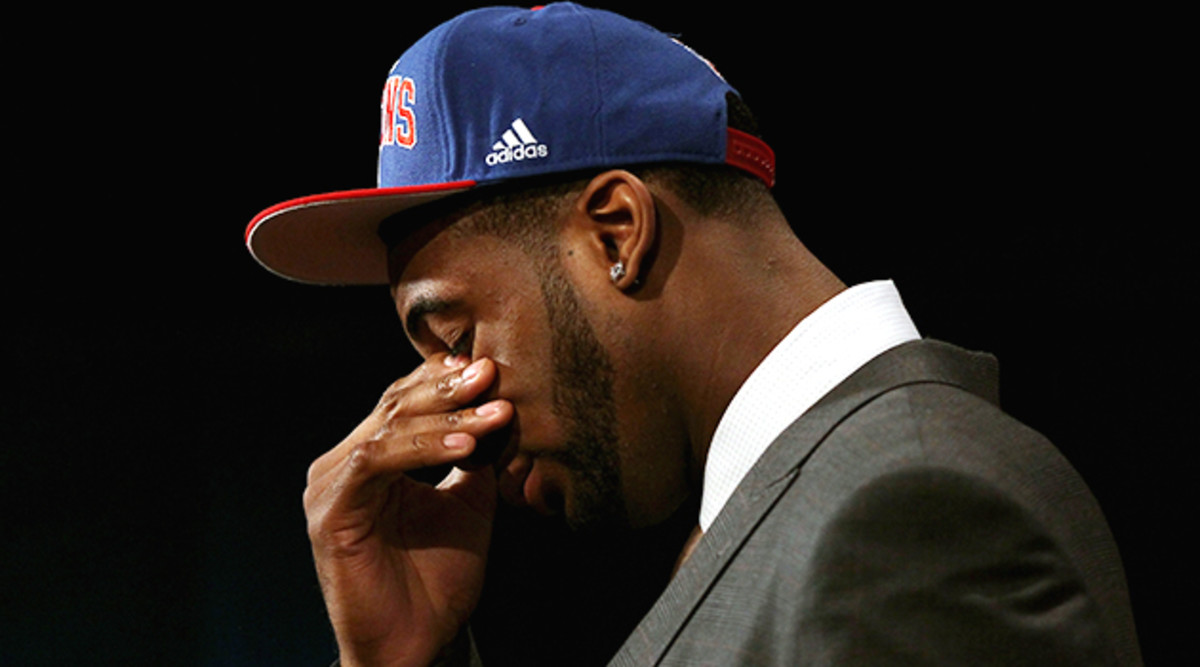
Drummond recounts the entire stomach-churning sequence with much detail but no bitterness. “I broke down when Detroit called,” he says, “because I was so happy.”
******
George David accompanied Drummond to the 2013 All-Star weekend in Houston. Drummond had been selected to play in the Rising Stars Challenge, and even though he was injured, he wanted to attend. David, then the Pistons’ assistant GM, caught Drummond gazing longingly at the posters of All-Stars in the airport and at the hotel. When they returned to Detroit, David asked Drummond for his takeaway. “I don’t know if I want to go back,” Drummond said, “unless I’m playing on Sunday.”
If David wasn’t already convinced that the Pistons made the right pick, he was then. He had spent a week scouting Drummond at UConn and saw what others may have missed: the way he smiled when he practiced and the way he stayed after for extra work instead of sprinting to the locker room. The Huskies faltered for many reasons. Drummond did not fix the problems, but he did not cause them either. “He conforms to the group,” says former UConn assistant Patrick Sellers, which is why he was so excited when Van Gundy came to Detroit, telling Drummond, “This is going to be the best thing for you.”
Bob Myers: Why Stephen Curry deserves SI’s Sportsman of the Year
The Pistons brought Drummond along slowly, first as a backup to Jason Maxiell, then a sidekick to Monroe. He could be brilliant one moment, as when he stripped Heat guard Dwyane Wade twice in 43 seconds, and bumbling the next. He spent all of last summer with Malik Allen, adjusting to his new responsibilities. “He used to just screen-and-roll, screen-and-roll, and you could throw that thing to the moon because he’d go get it,” Allen says. “But when the lob wasn’t there, they tossed it into Greg, and Dre became kind of an afterthought.”
Without Monroe, Drummond still starts virtually every possession with a high screen-and-roll, sucking in the defense. But if the Pistons can’t score off that initial action, he seals his man and raises his hand. Drummond admires elaborate back-to-the-basket moves—he studies the low-post stylings of Hornets center Al Jefferson and pesters Big Al about training with him—but the Pistons encourage him to simplify. While the ground-bound Jefferson requires a diverse repertoire, the spring-loaded Drummond can tally 20 points with nothing but dunks, putbacks and jump hooks. He can grab 20 rebounds with nary a box-out. “It’s like a sensor goes off inside of me,” Drummond explains. “I just go get the ball.”
Van Gundy harps at Drummond to show such gusto away from the glass. After a practice in L.A., at USC’s Galen Center, Van Gundy sits next to Drummond and reviews clips of every screen he set in a loss to the Kings. Van Gundy wants Drummond to see how Detroit surged when he rolled hard and lagged when he let up. Watching coach and player, in the early stages of a beautiful basketball marriage, it is hard to imagine that they'll ever split. But the same might have been said about Howard and Van Gundy back in ’07, and their divorce played out in the ugliest way: at a press conference in Orlando, five years later, when Van Gundy told reporters that Howard was lobbying for his ouster. In a month Van Gundy was fired, and four months after that Howard was traded to the Lakers. He hasn’t been the same since.
• JENKINS: Special bond for players and their moms |Drummond for MVP?
Staffers who followed Van Gundy from Orlando to Detroit detect subtle changes in his hard-driving ways—practices are shorter, for instance—but he will never babysit stars. “All coaches want the same things,” says a former Magic player. “The difference is, Stan tells you what they are. He’s transparent. And not everybody likes hearing it.” Drummond has responded, overhauling his pregame routine to build energy and focus. He hits up sushi restaurants before every tip-off, in part so he can eat light (usually crab or shrimp), then catches a cab to the arena, often arriving before the bus. He plops down at his locker and meditates.
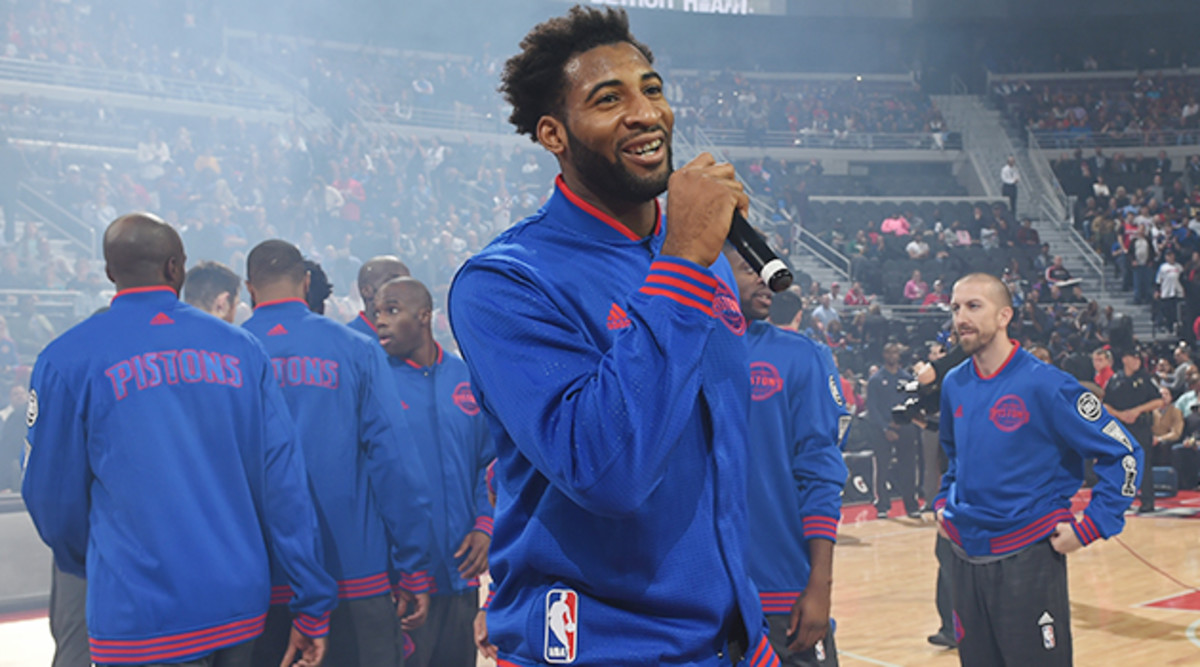
Drummond will be a restricted free agent next summer, which means the Pistons will re-sign him to a maximum contract or match whatever offer another team presents. He has graduated from project to pillar, inviting Stanley Johnson to live with him when the rookie’s mother died of breast cancer in August, and gathering players in the Sleep Train Arena locker room when they fell to the Kings. “We can't let this take us away from who we are,” he preached. But he is still the same age as college seniors. He shoots 42.5% from the free-throw line. He gets three calls from his mom during a 45-minute interview. He smiles at the name flashing on the screen.
“She keeps me grounded,” he says, “because there are so many distractions in this game, so many things going on off that court. It’s stressful.” He is talking about money, fame, temptation. He is reminded that it’s only beginning. “I know,” he says, with a nod and a laugh. Where he’s headed there are no disguises.
